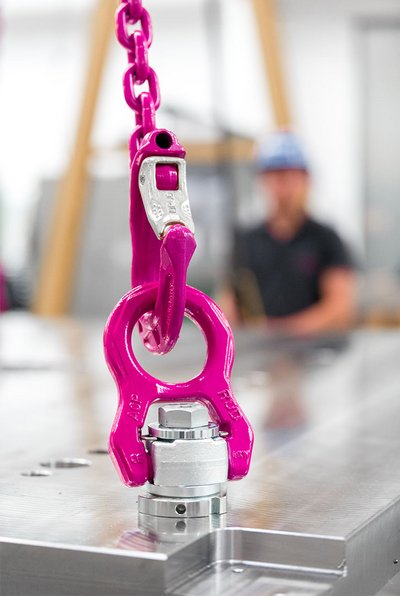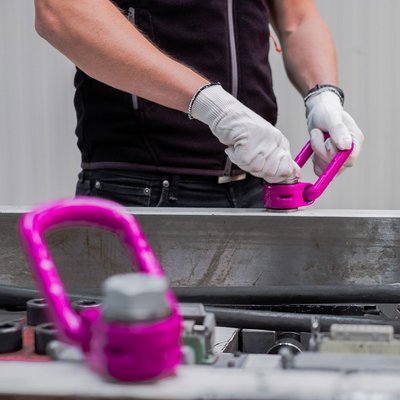Straight to the point.
This is important to remember when buying lifting points!
They are often underestimated during the design process, not taken into account enough, and sometimes even forgotten: As an integral part of the lifting system, lifting points, together with the lifting chains, connect the crane with the load when lifting, rotating and turning. These are eyebolts, eyelets, fixing lugs, etc., to which the means of lifting are attached using hooks, shackles or other connecting elements. Modern lifting points form the basis for the safe movement of loads, help to prevent damage during transport, and help to keep the transport options of machines flexible.
There is no question that lifting points offer a high level of safety today. But one thing is also certain: When designing machines and other goods, it pays off to consider the lifting points you will need later on at an early stage in the process. “Later on” in this case means throughout the entire process – from production, internal transport, transport to the installation site and assembly, all the way through to any relocation or recycling. With all this in mind, you would be well advised to bring together specialists from design, production, logistics, supply chain management as well as a safety officer before the real work begins. .
From eyebolt to lifting point.
A lot had to happen before lifting points became as safe and reliable as they are today. Unfortunately, many accidents had to happen too. More than 40 years ago, for example, an investigation revealed that a series of accidents in underground operations was mainly due to broken DIN 580 eyebolts. They were the most common lifting points at the time. The trade association reacted immediately and banned the use of the eyebolt for this purpose. At the same time, it made new demands: Lifting was only allowed with devices that offered four times the safety against breakage in all directions. In doing so, the trade association laid down the principles for modern lifting points, which to this day make work safer while significantly reducing handling times. Eyebolts in compliance with DIN 580 are now only used as assembly aids.
In addition to the conveyor system and means of lifting, lifting points are an important part of the lifting technology. While conveyor technology includes cranes, industrial trucks and load-handling equipment, lifting means – lifting chains and other components – connect the conveyor technology with the load. Which conveyor technology is used and which lifting means are most suitable for a particular application depends greatly on the type and nature of the load to be lifted. This also applies to the choice of the appropriate lifting point, but a number of additional criteria come into play as well.
Machinery Directive 2006/42/EC 5 makes a clear stipulation: Above a certain dead weight of the construction, a suitable suspension or a device for attaching a lifting point is required – or even several. Among other things, this ensures employee safety, health and ergonomics. The directive is especially aimed at designers of machines, systems, moulds, etc. The only question is: Which lifting point is the right one for which application?
Types of lifting points.
Lifting points are available in versions to screw, connect and weld. Screw connectable lifting points are by far the most frequently used. They can be assembled as required and dismantled with little effort when they are no longer needed. As they are available for all standard threads, they can be used in a variety of ways. This makes them very flexible in use. Weldable lifting points (welding points), on the other hand, are permanently connected to the load. The advantage is that an accidental unscrewing of the lifting point, e.g. when rotating and turning loads, is impossible.
In addition to the division into screw connectable and weldable lifting points, rigid and swivel lifting points are also available. Rigid variants consist of eyebolts or weldable eyelets. Because their pulling direction cannot be changed, they are preferably used in single-strand solutions. The area of application for rotating or swivelling lifting points is usually multi-strand solutions. This is because in this application, the lifting points must align themselves in the direction of pull when the load is lifted. Rotating and pivoting lifting points are therefore more flexible than rigid variants .
Rotating and turning.
Special lifting points for rotating and turning have special application advantages and therefore offer considerable added value. They are equipped with a ball bearing and allow full WLL under rotation, making them the right choice for these applications. The advantage is that, thanks to the ball bearing, the forces resulting from lifting are converted into a rotating movement without jerking. Such jerk-free rotation under load is not possible without ball bearings, because impact to the complete system cannot be avoided. Tip: For susceptible surfaces, choose a lifting point that ensures sufficient distance to the load and does not damage it.
The WLL.
It is rarely the case that lifting points are only loaded vertically from above during lifting, that the load does not move or that no other forces that are difficult to calculate act on the lifting point. Therefore, lifting points must be measured to withstand a wide variety of WLLs. And these depend on their attachment, positioning and quantity. For this reason, the WLL indicated on the lifting point and in the operating instructions always indicates the WLL under the most unfavourable load conditions.
The risk analysis.
Before you, as a designer or user, make the decision for a lifting point, you should always carry out an appropriate risk analysis; be it an integrated lifting point or an attachable lifting point. In doing so, please observe the following factors:
- The lifting point or lifting eye should not have any sharp edges.
- The eyelet diameter must be suitable for the hooks being used.
- Wall thicknesses and edge distances must be selected so that the safety flaps on the hook are guaranteed to fold in.
- The suspension must be designed with four-fold protection against breakage in any direction, as WLLs in all conceivable directions could occur during manufacture, transport and assembly of the structure (see above).
- A specific marking must be provided.
General selection criteria.
You should always consider several general criteria when selecting a lifting point. The ideal procedure: First determine the weight and centre of gravity of the load. Then determine the number of lifting points to be used depending on the number of strands of the lifting chain and the installation position. Following the operating instructions, observe the reduction factors resulting from the tilt angle and the temperature influences. Select the correct lifting point in accordance with the type of use with a WLL that exceeds the previously determined weight. However, the optimal selection starts with the manufacturer of the lifting point. Also make sure that it is marked with a WLL, the manufacturer and CE. The lifting point should have a valid TA test certificate compliant with guideline DIN EN 1677. This is proof that the manufacturer has the necessary testing technology and employs specialist staff to carry out production control tests on the products in accordance with the principles of DIN EN 1677. These tests include the application of the test force, batchwise destructive tensile tests and the test for freedom from cracks. A certified QM system in compliance with DIN EN ISO 9001:2008 is also important.
Design documents and calculation programs.
It can be very helpful if the manufacturer provides you with design documents in 2D and 3D, as well as calculation programs for the solution of your lifting tasks. This is not only practical and convenient, it is also important because the programs or apps take the most important factors into account when calculating the correct WLL of the lifting point, for example:
- the number of strands to be lifted,
- the influence of the angle conditions during the lifting process and
- the shape of the structural element (symmetrical or asymmetrical).
Lifting points that are easy to test.
Lifting points have a lot to withstand in everyday industrial practice. Bulky machines or heavy moulds are lifted, rotated and turned. It is therefore obvious that the lifting points used need to be subject to regular inspections for operational safety. But testing alone is not enough. Understandably, the law demands that every single test be precisely documented. Although searching for each product from an Excel list or even from index cards and recording the test there would be in compliance with the guidelines, it would also be extremely time-consuming with large stocks of lifting points. It becomes easier and more economical if you, as a user, can fall back on RFID technology. This means that you can equip your lifting points with RFID transponders, on which a unique number is stored. At RUD, many products already leave the factory with them installed. A reader is used to identify the products and transfer their data to cloud-based software. This makes it much easier and more convenient for the operator to stay on the safe side legally. Moreover, the stored information for each product can be called up online – including the test criteria.
This additional safety and comfort function is yet another good reason to take a close look when selecting the lifting points.
Checklist for purchasing lifting points:
- Does a specific manufacturer have to be selected e.g. due to internal guidelines?
- How many lifting points are required per component?
- What WLL does the lifting point need?
- Are there any design dimensions to consider?
- What are the loading directions of the lifting point?
- What approvals does the lifting point need?
- Which certificates does the lifting point need?


